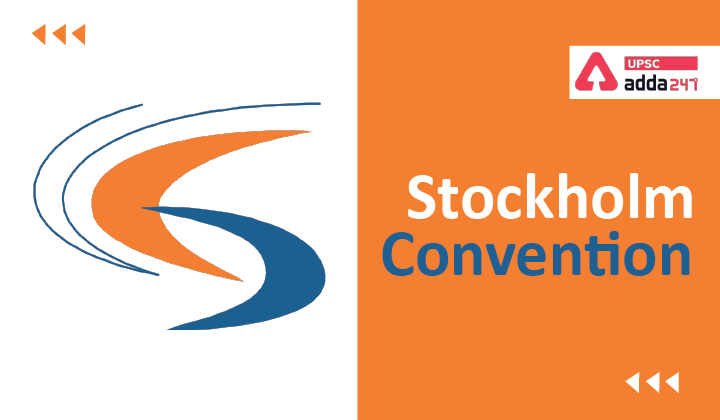Table of Contents
Stockholm Convention: Relevance
- GS 3: Conservation, environmental pollution and degradation, environmental impact assessment.
About Stockholm Convention
- The Stockholm Convention is a global treaty to protect human health and the environment from persistent organic pollutants (POPs).
- The Stockholm Convention has entered into force in 2004.
Stockholm Convention: Key points
- UNIDO (United Nations Industrial Development Organization) is also responsible for supporting developing countries and countries with economies in transition to implement the Stockholm Convention.
- The Global Environmental Facility (GEF) is the designated interim financial mechanism for the Stockholm Convention.
- India has signed the Stockholm convention in 2002 and brough it into force in 2006.
- In Oct 2020, the union cabinet approved the Ratification of seven (7) chemicals listed under Stockholm Convention on Persistent Organic Pollutants (POPs).
What are POPs?
- POPs are chemicals that remain intact in the environment for long periods, become widely distributed geographically, accumulate in the fatty tissue of humans and wildlife, and have harmful impacts on human health or on the environment.
- Under Stockholm convention, below are the 12 POPs that were initially considered.
| Category | Persistent Organic Pollutant |
| Pesticide |
|
| Industrial Chemicals | 10. Hexachlorobenzene
|
| By-Products | 12. Polychlorinated dibenzo-p-dioxins and Polychlorinated dibenzofurans (PCDD/PCDF) |
The COP in 2017 added 16 new chemicals to the Stockholm Convention. Below are the 16 newly added chemicals under Stockholm Convention
| Alpha hexachlorocyclohexane | Pentachlorobenzene |
| Beta hexachlorocyclohexane | Pentachlorophenol and its salts and esters |
| Chlordecone | Perfluorooctane sulfonic acid (PFOS), its salts and perfluorooctane sulfonyl fluoride (PFOSF) |
| Hexabromobiphenyl | Polychlorinated naphthalenes |
| Hexabromocyclododecane | Technical endosulfan and its related isomers |
| Hexabromodiphenyl ether
and heptabromodiphenyl ether (commercial octabromodiphenyl ether) |
Tetrabromodiphenyl ether
and pentabromodiphenyl ether (commercial pentabromodiphenyl ether) |
| Hexachlorobutadiene | Decabromodiphenyl ether
(Commercial mixture, cDecaBDE) |
| Lindane | Short-chain chlorinated paraffins (SCCPs) |
IMPORTANT: The earlier given 12 POPs are important for UPSC exam. The 16 POPs are given only for your reference, you did not need to remember the names of these POPs.
Stockholm Convention objective
- Eliminate dangerous POPs, starting with the 12 worst
- Support the transition to safer alternatives
- Target additional POPs for action
- Clean-up old stockpiles and equipment containing POPs
- Work together for a POPs-free future
Stockholm Convention history
- The Stockholm Convention on Persistent Organic Pollutants was adopted in 2001 and entered into force in 2004. However, the discussions on POPs started way before. Below are the events that are important for UPSC exam.
- In 1995, UNEP requested in its decision that an international assessment process be undertaken of an initial list of 12 POPs.
- In 1997, the UNEP Governing Council in its decision invited UNEP to prepare for and convene intergovernmental negotiating committee (INC), to prepare an international legally binding instrument for implementing international action initially beginning with the 12 POPs.
- The first meeting of the INC to develop an internationally legally binding instrument for implementing international action on POPs was held in 1998 in Montreal, Canada, at which the Criteria Expert Group (CEG) requested above was established.
- The CEG completed its mandate in two meetings: the first in Bangkok, Thailand, in October 1998 and, the second, in Vienna, Austria, in June 1999.
- The Convention entered into force on 17 May 2004, ninety days after submission of the fiftieth instrument of ratification, acceptance, approval or accession in respect of the Convention.
Also Read:





 TSPSC Group 1 Question Paper 2024, Downl...
TSPSC Group 1 Question Paper 2024, Downl...
 TSPSC Group 1 Answer key 2024 Out, Downl...
TSPSC Group 1 Answer key 2024 Out, Downl...
 UPSC Prelims 2024 Question Paper, Downlo...
UPSC Prelims 2024 Question Paper, Downlo...





